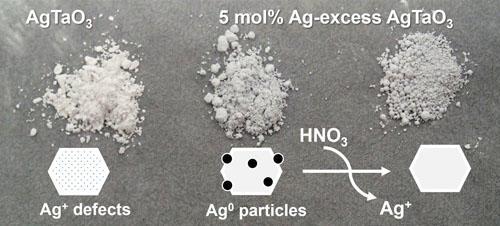
Improvement of water splitting activity of silver-excess AgTaO3 photocatalysts via nitric acid washing treatment
F. Amano, S. Nakayama
Journal of Environmental Chemical Engineering 10(4), Article 108089, 2022, https://doi.org/10.1016/j.jece.2022.108089
Silver tantalate (AgTaO_{3} with a bandgap of 3.4 eV) particles loaded with Rh-Cr oxide cocatalyst are used as photocatalysts for water splitting reactions with a high apparent quantum efficiency (AQE). AgTaO_{3} prepared via solid-state reaction at high temperatures may possess metallic Ag particles on the surface, resulting in Ag~{+} defects in the bulk of the material. These defects result in low activity owing to the increase in the recombination of photogenerated electrons and holes. Therefore, adding Ag in excess to suppress the formation of Ag~{+} defects would improve the photocatalytic activity of AgTaO_{3}. In contrast, the excess Ag forms numerous metallic Ag particles on the AgTaO_{3} surface, which decrease the photocatalytic activity owing to the electron migration to the Ag particles. This study investigated the effectiveness of washing treatments using concentrated HNO_{3} to remove the metallic Ag particles formed on the Ag-excess AgTaO_{3} surface. After loading the Rh_{0.5}CrO_{x}/AgTaO_{3} cocatalyst, the water splitting activity of AgTaO_{3} photocatalysts prepared with varying amounts of excess Ag and washed with different concentrations of HNO_{3} was examined. The water splitting activity of 5 mol% Ag-excess AgTaO_{3} improved significantly when treated with 13 M HNO_{3} for 1 h. While the AQE of overall water splitting was 20% for the Rh_{0.5}CrO_{x}/AgTaO_{3} prepared in a stoichiometric ratio, the Rh_{0.5}CrO_{x}/AgTaO_{3} with excess Ag showed higher activity (AQE = 39% at 254 nm) after washing with concentrated HNO_{3}.